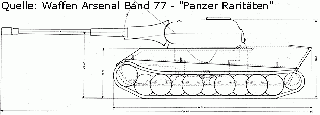Löwe
Lowe (Stock)
| 12500 가격 |
| 1650 내구력 |
| 89.85 / 99.85 kg중량 |
- 지휘관
| 120/100/80차체 장갑(정면/측면/후면, mm) |
| 120/80/80포탑 장갑(정면/측면/후면, mm) |
| 800 마력엔진 출력 |
| 35 km/h최대 속력 |
| 24 도/초회전 속도 |
| 320 기본 포탄 공격력 |
| 234 mm기본 포탄 관통력 |
| 12 클립 재장전 시간 |
| 23 도/초포탑 회전 속도 |
| 400 m관측 범위 |
| 710 m통신 범위 |

Designed for sniping, the Löwe is armed with the very accurate 10.5 cm KwK46 L/70, and is paired with a rather decent hull. While not quite as heavily armored as the Pz.Kpfw. Tiger II, it's sufficient to protect it from tier 7 guns. The turret however is heavily sloped allowing it to bounce even high tier guns . The performance of this tank is quite good for its tier, provided that it does not engage in close quarter combat, which is almost certain death for this tank. It has poor acceleration, so any reversal in direction will take some time. As a premium tank, it produces a significantly higher credit income than a typical tier 8 tank. The Löwe was added in the 0.6.4. patch, along with the KV-5 heavy tank.
Compatible Equipment
Compatible Consumables
Player Opinion
Pros and Cons
Pros:
- Excellent accuracy
- Excellent gun for a tier 8 heavy
- Better accuracy and penetration than thr Tiger II's top gun
- Very strong gun mantlet (comparable to JagdTiger's superstructure)
- Excellent money maker
Cons:
- Sluggish
- Large size, easy artillery target
- Large lower glacis
- Easily catch on fire
- Tank has under average hp/weight ratio
Performance
"The Lion" is primarily a support tank. Do not use it to lead an attack. It will perform better when fighting from the rear of an attack group, from ambush, or sniping at long range. It shoots accurately, quickly, and painfully. The Löwe suffers from classic German disadvantages: a tendency to easily suffer damage to the engine, and (often as a result) to light on fire. With a top speed of only 35, you might want to consider using high-octane Gasoline. Despite this, the Löwe is very maneuverable, or at least it is when on firm ground.
The Löwe has earned a perhaps undeserved reputation for being piloted by bad players, due to new players often buying this tank without proper previous experience in driving a heavy. Make no mistake - on the whole, the Löwe is an awesome weapon. However it is quite difficult to fulfill its potential. The armor is quite thin for a heavy tank and often even mediums or lower tier heavies will be able to penetrate it. It is strongly advised you get some experience piloting a Pz.Kpfw. VI Tiger before attempting to master the Löwe. Adding equipment will improve this tank's performance considerably.
Historical Info
In the early months of 1942, Krupp was ordered to start the process of designing new heavy tank designated PzKpfw VII Lowe (VK7201). Its design was based on previous project by Krupp designated VK7001 (Tiger-Maus) and created in competition with Porsche's designs (including first Maus designs). VK7001 was to be armed with either 150mm Kanone L/37 (or L/40) or 105mm KwK L/70 gun. Lowe was to utilize Tiger II's components in order to simplify the production and service.
Designers planned to build two variants of this streamlined vehicle with rear mounted turret. Light (leichte) variant would have frontal armor protection of 100mm and it would weight 76 tons. Heavy (schwere) variant would have frontal armor protection of 120mm and it would weight 90 tons. Both variants would be armed with 105mm L/70 gun and coaxial machine gun. It is known that 90ton schwere Lowe was to have its turret mounted centrally and in overall design resembled future Tiger II. Variants of Lowe were both to be operated by the crew of five. It was calculated that their maximum speed would range from 23km/h (schwere) to 27km/h (leichte). Adolf Hitler ordered that the design Leichte Lowe was to be dropped in favour of Schwere Lowe. Lion was to be redesigned in order to carry 150mm L/40 or 150mm L/37 (probably 150mm KwK 44 L/38) gun and its frontal armor protection was to be changed to 140mm. In order to improve its performance, 900-1000mm wide tracks were to be used and top speed was to be increased to 30km/h. In late 1942, this project was cancelled in favour of the development of the Maus. During the development of Tiger II, designers planned to build redesigned version of Lowe (as suggested by Oberst Fichtner), which would be armed with 88mm KwK L/71 gun and its frontal armor protection would be 140mm (as planned before). Redesigned Lowe would be able to travel at maximum speed of 35km/h and it would weight 90 tons. It was to be powered by Maybach HL 230 P 30, 12-cylinder engine producing 800hp. Lowe would be 7.74 meters long (with the gun), 3.83 meters wide and 3.08 meters high. Lowe would be operated by the crew of five. It was planned that Lowe would eventually replace Tiger II.
From February to May of 1942, six different designs were considered, all based on the requirements for Lowe. On March 5/6th of 1942, order for heavier tank was placed and project Lowe was stopped in July of 1942. Lowe project never reached the prototype stage but it paved the way for its successor's development - Porsche's Maus.
Historical Gallery
Sources and External Links
| Light Tanks | |
| Medium Tanks | |
| Heavy Tanks | |
| Tank Destroyers | |
| Self-Propelled Artillery |
| USA | |
| UK | |
| Germany | |
| USSR | |
| China | |
| Japan |
